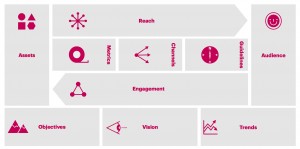Community
May 17, 2014
Tools from Post-Ac / Alt-Ac Careers: The Digital Engagement Framework
Since finishing my MA and deciding to pursue a career outside academia instead of a PhD, I have encountered plenty of discussions and discovered several resources that could fit just as well within academic projects in the humanities. As a Museum and Communications Coordinator for a non-profit heritage organization, issues surrounding collecting, archiving, and organizing information, cultural objects, and historical narratives are always present in my work. Many of these issues are related to how we can best engage an audience in these materials and narratives using digital platforms. This is the first of a few posts that I hope to write in order to share tools from my work outside academia that I feel would be useful to the EMiC community. Anyone else who has ideas and resources to share that bridge the divide between academia and post-ac / alt-ac careers should feel encouraged to do the same.
I attended two workshops at the Canadian Museums Association conference in Toronto this April, one of which was about incorporating digital strategies into project planning. The workshop was led by Jasper Visser, who travels the world to give talks on The Digital Engagement Framework. This framework is a tool that helps you decide which digital technologies will best achieve your goal and engage people in your project. The framework encourages users to map out who their audience is, what they can offer this audience, and what the audience can offer in return. The next steps involve planning how digital tools can be used to facilitate a mutually beneficial relationship between the project organizers and their audience. Visser has created an entire book on the topic that includes worksheets and case studies. It can be downloaded (along with the worksheet pictured above) from the digital engagement framework website.
I found the tool very useful for streamlining ideas about crowd-sourced projects that depend on audience contributions. Visser’s workshop asked participants to think past the initial engagement of an audience and also create a strategy that will retain an audience and cause an audience to be invested in a project. Since invested audiences need to feel that they are adding value to a project and that their efforts are recognized, the workshop included ample discussion on social media and how it can support crowd-sourced projects. The workshop also forced me to realize that, since only about 1 out of every 100 people remain interested in a project after initial engagement, targeting an audience 100 times the size of my ideal audience is a necessary first step in obtaining the participation levels I would like to achieve.
All in all, I think this resource is a useful tool for anyone planning a digital project that will use crowd-sourcing to obtain materials (such as an online edition that will ask for annotations from readers), for anyone who has a non-digital project that will require digital tools to engage with an audience (such as a textual edition that will be promoted through social media and other online platforms), or simply for anyone who has a project in mind and wants to take the first steps in considering how to get people interested in it– specifically in a world where digital interactions are not only the norm, but a necessity for generating a large and invested readership.

This is a fascinating post both on alt-ac positions and on digital tools. Thank you for sharing the link too! I would be really interested in hearing about the results of crowd-sourcing for digital editions. Does anyone have any experience with this that they can share?